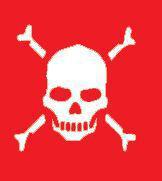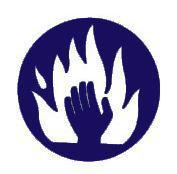SAS Urban Survival Handbook (133 page)
Read SAS Urban Survival Handbook Online
Authors: John Wiseman
Tags: #Health & Fitness, #Reference, #Survival, #Fiction, #Safety, #Self-Help, #Personal & Practical Guides, #General, #Survival Skills


REMEMBER
ALWAYS elevate the bleeding limb, above the level of the heart, to make it easier to staunch serious bleeding.
Stab wounds
Most knife wounds involve slashing injuries and may lead to serious bleeding. Stab wounds caused by a knife or any other sharp object can be extremely serious. The actual puncture may be small, but internal injuries are likely.
If the knife (or other sharp object) is still in the wound, do NOT attempt to remove it. Treat
☜
SEVERE BLEEDING by applying pressure beside the knife or around it. If there are other cuts or wounds, apply direct pressure to them. If bleeding is extensive, check for signs of SHOCK ☞ Keep the casualty as calm as possible while waiting for help to arrive.

WARNING
Do NOT move a casualty more than absolutely necessary, especially if there is a knife or other sharp object embedded in a wound—it could cause further injury.
Gunshot wounds
If the ‘bullet’ passes straight through, the exit wound is often larger than the entry wound. Serious damage to tissues, organs, blood vessels and nerves may result from any gunshot wound. Internal bleeding may be more extensive than external—watch for signs of SHOCK ☞
ALWAYS check to see if there IS an exit wound. Calm and reassure casualty. Deal with ☜ SEVERE BLEEDING while waiting for the ambulance to arrive. Monitor ☜ BREATHING and ☜ PULSE until help arrives.
SHOCK
Shock is caused by a serious and dangerous reduction in the blood flow or fluid levels in the body. It should NOT be confused with post-traumatic stress disorder, which follows an emotional or physical trauma.
Severe bleeding, loss of body fluids from severe burns or from persistent/prolonged vomiting or diarrhoea commonly lead to shock. Shock may also be caused by a heart attack/ failure of an artery or electrocution.
The priority is to encourage the supply of blood to the vital organs—the heart, brain and lungs.
Symptoms
- ◑ Skin cold and clammy
- ◑ Casualty weak/dizzy/faint
- ◑ Pulse is shallow and rapid
- ◑ Casualty may be thirsty
- ◑ Vomiting/unconsciousness
- ◑ Skin paler than normal (greyish)
- ◑ Loss of colour in lips
You MUST act quickly. Do NOT excite the casualty in any way or move them more than absolutely necessary. Shock is life-threatening. CALL AN AMBULANCE and apply first aid to BURNS ☞ or BLEEDING ☜
Action
Reassure the casualty as much as you can. Lay them on their back (if conscious) with legs elevated about 30 cm (12 in). Loosen tight/restrictive clothing round neck, chest and abdomen.
Do NOT give anything to eat or drink. Cover to keep warm, but do NOT add heat—warming the surface of the body will draw blood away from the vital organs which need it most.
Treat and monitor injuries, especially check breathing and pulse. If there is loss of consciousness, impaired breathing or signs that vomiting may occur, place the casualty in the RECOVERY POSITION ☞ (bearing injuries in mind), until help arrives.
REMEMBER
Your attitude and actions are very important in treating shock. If you appear to be calm and in control of the situation, the patient will feel cared for and respond. Stay with them if you can—NEVER leave a shock victim on their own.
HEART ATTACK
 This is a general term which is often used to cover any sudden, painful heart condition. An artery supplying blood to the heart may become blocked or severely restricted. Part of the heart may die or the heart may stop.
This is a general term which is often used to cover any sudden, painful heart condition. An artery supplying blood to the heart may become blocked or severely restricted. Part of the heart may die or the heart may stop.
Symptoms
- ◑ Sudden, severe gripping pain in the chest (like extreme indigestion). Pain may spread to the shoulders, throat and down one or both arms.
- ◑ Casualty may sit down and seem withdrawn.
- ◑ Casualty clutches chest.
- ◑ Face, lips, hands and feet may lack colour.
- ◑ Sweating is likely.
- ◑ Breathing may be rapid, shallow and quiet, or may stop.
- ◑ Pulse (heartbeat) may be rapid, weak, erratic or may stop.
- ◑ Casualty may lose consciousness.
- ◑ Symptoms similar to SHOCK.
It is VITAL to act quickly to reduce the amount of work the heart has to do.
CALL AN AMBULANCE.
TELL THEM A HEART ATTACK IS SUSPECTED.
Reassure and support the casualty, sitting down—if necessary on the ground against a wall. Raise the knees slightly. DON’T excite, worry or move the casualty unnecessarily. Loosen any restrictive clothing. Monitor breathing and pulse until help arrives.
If the casualty stops breathing, loses consciousness or the heart DEFINITELY stops, be prepared to use ☜ MOUTH-TO-MOUTH and ☜ CARDIAC COMPRESSION. When ‘stable’, place in the RECOVERY POSITION ☞ until help arrives.

WARNING
Compression should only be carried out by someone who is trained in first aid, who has had practice in the technique and who can establish conclusively whether or not the casualty’s heart IS beating—even if only a faint pulse can be felt. You could stop the heart.
STROKE
In some cases, symptoms may be confused with the effects of alcohol (but no smell of alcohol will be present). Symptoms may develop suddenly over a period of hours or, more rarely, days.
Symptoms
Depending on the severity of the stroke:
- ◑ Headache, dizziness and confusion
- ◑ ‘Thumping’ pulse
- ◑ Unconsciousness or slipping into unconsciousness
- ◑ Drooping mouth, slurred speech, drooling
- ◑ Flushed face
- ◑ Pupils of the eyes unequal in size
- ◑ Casualty may urinate or defecate
You must act quickly. CALL AN AMBULANCE AND TELL THEM YOU SUSPECT A STROKE.
Reassure and calm the casualty. Lay them down with head and shoulders supported. Make sure saliva drains from the mouth—mop it up to make the casualty feel ‘better’. Loosen any restrictive clothing.
Monitor the casualty’s breathing and pulse. If the casualty becomes unconscious, place in RECOVERY POSITION ☞ Be prepared to apply ☜ MOUTH-TO-MOUTH if breathing stops, and ☜ CARDIAC COMPRESSION if heart stops.
BURNS/SCALDS
 Extremes of heat/cold, electrocution, chemicals or radiation can cause burn injuries. Scalds tend to be caused by ‘wet’ heat such as steam or hot liquids. The severity of the injury depends on the total skin area affected and the depth of the burn/scald.
Extremes of heat/cold, electrocution, chemicals or radiation can cause burn injuries. Scalds tend to be caused by ‘wet’ heat such as steam or hot liquids. The severity of the injury depends on the total skin area affected and the depth of the burn/scald.
Severe burns
- ◑ Lay casualty down and protect burn/scald area from contact with ground.
- ◑ Cool affected area IMMEDIATELY with clean, cold water.
- ◑ Remove any rings/watches/belts or constricting clothing from injured area before swelling starts. NEVER remove anything that is sticking to a burn/scald.
- ◑ Remove any clothing soaked in chemicals—take care not to burn yourself.
- ◑ NEVER cover burn/scald area in fluffy dressing—use sterile dressing
- ◑ DO NOT break blisters/remove loose skin or interfere with injured area. Try not to touch burns directly.
- ◑ Do NOT put ointments/lotions or fat on burn/scald area
- ◑ If casualty becomes unconscious, place them in the RECOVERY POSITION ☞
REMEMBER
The conscious casualty with serious burns/scalds MUST be reassured and comforted and also treated for fluid loss. Give sips of water—half a cup over ten minutes for adults. Children should sip water continuously.

WARNING
The risk of infection through damaged skin is VERY high in burn/ scald injuries. Keep infection to a minimum by using sterile/clean dressings and clean water to cool injured area. Shock can also develop in cases of large-scale burns/scalds owing to loss of body fluid. Watch for signs of shock and treat as for ☜ SHOCK.
